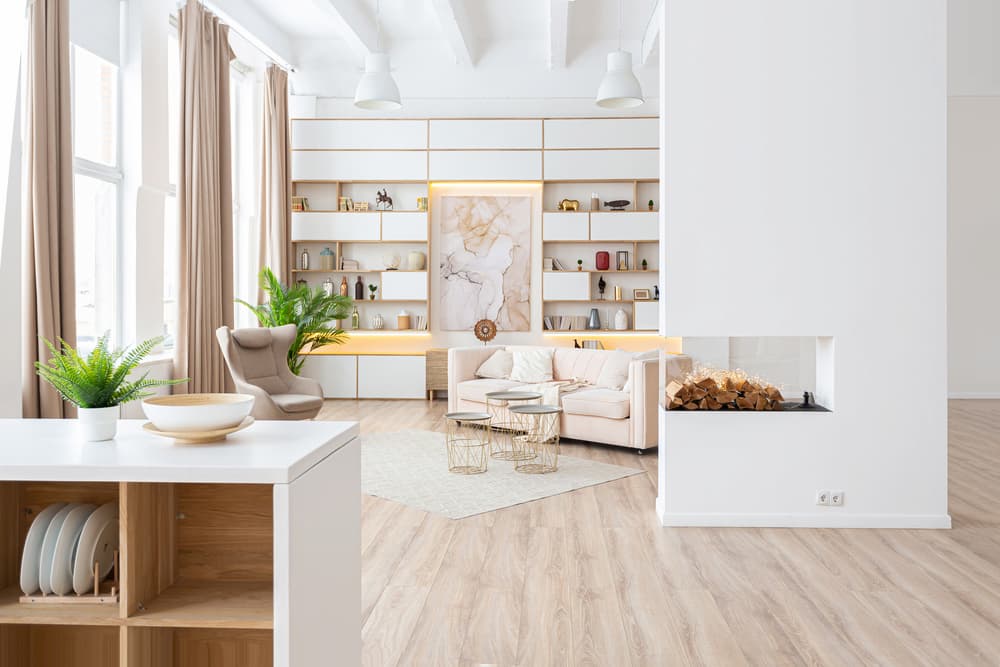How to Decorate in Contemporary Style
Updated: April 15, 2022
One of the first steps in designing any space is pinpointing the interior style you’re hoping to achieve. From traditional to modern and every style in between, there are plenty of options to choose from.
For a space that’s equal parts stylish, comfortable, and welcoming, decorating in a contemporary style can be an excellent fit. One of the biggest benefits of this specific interior design style is how easily it can be adapted for a specific room, home, or even personal preference. But even as customizations are made, a basic set of design principles ensures a beautiful, harmonious, and attractive final result.
What is Contemporary Style in Interior Design?
Contemporary style is exactly what it sounds like – in other words, it’s a style of decorating that reflects the of-the-moment design trends. At the same time, contemporary rooms follow a handful of flexible but established “rules” about colors, lines, and shapes.
Essentially, a contemporary style of decorating is characterized by subtle sophistication, intentional simplicity, clean lines, and texture. Rather than be defined by the things in a room, this style accentuates space.
What’s the difference between modern and contemporary styles?
Sometimes, the words “modern” and “contemporary” are interchangeable – but not when you’re talking about interior design. Despite their similar names, these are two different styles, each one representing a specific look and design era.
-
- Modern style is a reflection of the modernist movement. Based on Scandinavian style principles of simple, functional design, as well as the German Bauhaus schools of design, “modern” decor doesn’t actually equate to “new.” Most designers consider the era to span from the 1900s to the 1950s, eventually shifting into mid-century modern (1950s-1960s) and postmodern (1970s-1980s).
-
- Contemporary style began as a blend of many different styles in the 1970s, gradually settling into a more recognizable combination of ideas from modernism, postmodernism, art deco, and many others. But even today, contemporary design is constantly changing, incorporating current styles and trends.
Contemporary vs. modern design: Are there similarities?
One of the reasons that so many people confuse contemporary and modern style is that, despite their distinct differences, they also share some similar characteristics:
-
- Simple, uncluttered spaces
- Clean lines
- Artistic flair
- Common elements and materials include exposed glass, metal, and wood
- Calming, relaxing rooms that are very inviting
Does Contemporary Design Suit Your Style?
Wondering if you should learn how to incorporate contemporary design into your home? Because contemporary is a transitional style that tends to evolve with changing design trends, it’s very versatile and can appeal to many different personalities and tastes.
There are many interior designers and home stagers that favor contemporary spaces, mainly because the style is an excellent balance of simplicity and aesthetic character. With so many variations, contemporary decor style can be tailored for virtually any room or home. If you’re someone who appreciates new trends and ideas in the world of home interiors and enjoys frequently changing up the styling of your spaces, then contemporary decor could be the perfect style for you.
The Rules of Contemporary Design Style
You don’t necessarily have to be an experienced interior designer to craft living spaces modeled after contemporary style principles. In fact, because there are some basic guidelines that help define this particular style and a generous amount of flexibility, it’s one of the easier styles to work with.
Here is a useful guide to creating contemporary spaces in your home:
Color
Neutral colors are key, serving as the foundation of a room’s color scheme along with black and white. In some cases, bold colors may be very strategically used to create a contrast against neutral shades. Black is frequently used to ground the room.
With a fresh coat of paint in a classic neutral, you have an excellent start. If you are set on something pastel (or even vibrant), neutral colors should provide balance everywhere else. For example, custom window coverings in neutral tones can help offset walls painted in a subtle shade of blue.
Lines and space
In terms of the principles of contemporary design, strong and visible lines are unquestionably a part of the foundation of this style. Whether you prefer curved lines or straight vertical or horizontal lines, they should be carried through various elements of a room. Ideally, you’ll be able to trace the line through architectural details, high ceilings, and geometric designs and shapes in art. Bare windows can also be used as a way to accentuate the presence of the line.
In contemporary home interiors, bare, open space is just as important as the space filled with furniture and objects. “Less is more” should be your rule of thumb, from the walls to the areas between furniture. This approach ensures that every single piece is given the attention it deserves, standing out as unique.
Contemporary furniture
Contemporary-style furniture makes a statement without going overboard, striving for simplicity above all. Look for pieces that don’t have decorative elements or curved lines, opting instead for smooth and cleanly defined shapes. Exposed legs, pillows in geometric shapes, and uncluttered designs are key. Stay away from excessive decoration like ruffles, tassels, fringe, or carvings. Upholstery fabrics can be black, white, or a neutral shade, and natural materials such as wool, linen, cotton, and jute bring texture into the space.
Shopping for furniture for contemporary rooms doesn’t have to be an endless search. Instead, take advantage of the virtually endless possibilities of custom furniture design to create something that flawlessly fits your vision.
Lighting and art
Both lighting and art add warmth, personality, and brightness to any home, including those featuring a contemporary design. Lighting options like recessed or track lighting brighten up any room, while indirect or cove lighting provides a necessary balance. You can use picture lights or spotlights to draw attention to sculptures or framed art, which should frequently be placed at eye level for easy viewing.
Art frames may be a mix of metal, natural wood, or black (matte or glossy) finishes. Even though a collection of art can be hung together in a gallery wall-style set-up, steer clear of too much visual clutter.
Flooring
Flooring, just like furniture and decorative items, should strive for simplicity. Wood or tile floors provide smooth, sleek open space, which you can soften with an understated area rug.
Other elements
Throughout the space, metal, stone, and glass are nearly always a wonderful choice for contemporary rooms. Fabrics with a generous amount of texture, in the form of pillows, rugs, and drapery, can soften up a space. Classic, two-tone prints can be incorporated, but colorful, busy prints are better off left for other design styles.
Your decor, including plants, rugs, and accent items, should also follow the “less is more” principle. The simplest pieces can bring the most drama to a room without weighing down the design with unnecessary elements.
Bring Contemporary Style to Your Home with Interior Essentials
Whether you’re working with a “blank canvas” space or just updating a room, contemporary style may be the exact look you’ve been searching for. You can shop for high-end window coverings, decorative items, furniture, and more at the Interior Essentials furniture and decor stores in Scottsdale and Gilbert. Plus, our design services and custom options make it possible to create a space that’s true to your vision.
Visit Interior Essentials to discover how custom furniture, decor, and drapery can turn your house into a stylish, beautiful home.
Featured Image: PinkyWinky/Shutterstock

